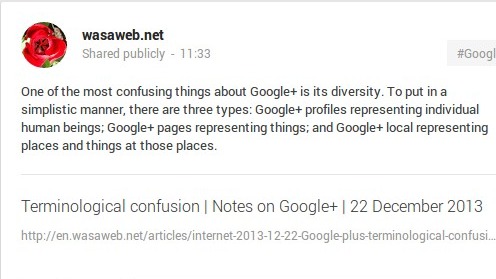This is a clarificatory or explanatory note to a piece (Terminological confusion Notes on Google+ 22 December 2013) I have written yesterday. This clarification or explanation was necessitated due to infelicitous wording on my part, when I shared the mentioned post on Google+ as explained below. The post has been shared a few times, and generated a few comments, and valid points have been raised: I would like to thank those who have shared and commented on the post and prompted me to write this note, though I feel it would be rather invidious to name individuals.

A link to the article was shared with the accompanying text that read as follows.
One of the most confusing things about Google+ is its diversity. To put in a simplistic manner, there are three types: Google+ profiles representing individual human beings; Google+ pages representing things; and Google+ local representing places and things at those places.
It was badly worded, since it together with the title of the link (Terminological confusion Notes on Google+ 22 December 2013) could reasonably be read to suggest that many users of Google+ may be confusing the concept of three types of Google+ entities, instead of confusion arising from the lack of standardized and easily differentiated terms for the three distinct types of Google+ entities that I had wished to write about.
To expand on the point made in the preceding paragraph, I think most people will understand when explained clearly that there are three different types of Google+ entities representing three different relationships: Google+ profiles representing individual human beings, Google+ pages representing things, and Google+ local representing places and things at those places. The terminological problem arises when people do not know what to call these different Google+ entities, even though they know what they are. For example, I have come across cases where some people use the expression Google+ page when they actually meant a Google+ profile: they were perfectly aware of the differences between the two, and that it (in this case a Google+ profile) represents or ought to represent a person. Such mistakes will occur time to time, as it may even be a slip of the tongue, and I do not think it is too serious.
However, I believe there exists a huge problem with regard to Google+ pages. In my view, Google+ pages refer to two distinct types of Google+ entities. In other words, and being somewhat unnecessarily obvious, two different things are called by the same name. Local Google+ pages sound like a subset of Google+ pages, even though in my opinion they are different types of their own. And this causes confusion, since participants in a dialogue or a conversation cannot immediately and unambiguously recognize which type of Google+ page is being discussed, a local Google+ page or – for lack of a better expression – a non-local Google+ page. It is entirely possible for example both parties in a dialogue to understand perfectly well that there are two types of Google+ pages, local and non-local, but they do not know which type of Google+ page is being discussed, without first defining it by a convoluted way, such as stating that the page is local, non-local, brand, etc.
Local and non-local Google+ pages represent different things in nature and conceptually distinct, and nothing demonstrates that fundamental difference better than the functional differences such as the existence of reviews for local Google+ pages and the fact that one is not the same as other to the extent that it is not possible to convert a non-local Google+ page into a local Google+ page and vice versa. As such, it would make sense to me for these two clearly different entities to be called by two clearly and easily distinguishable names, so as to avoid confusion arising from this terminological muddle.
